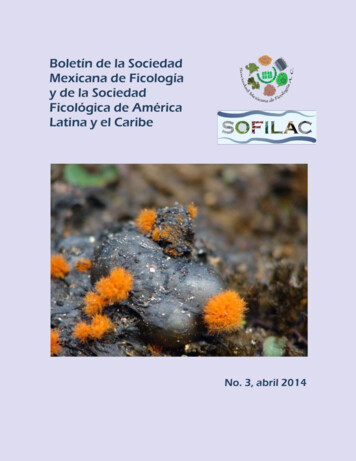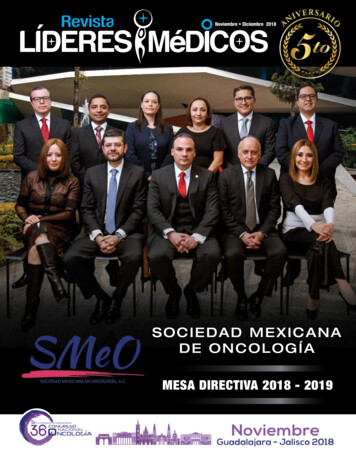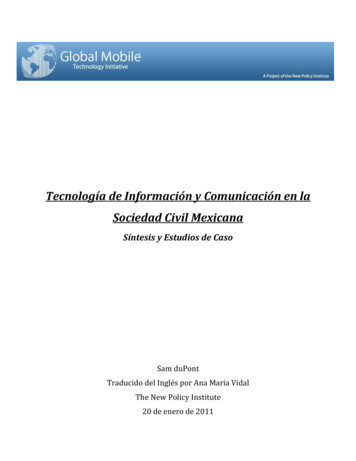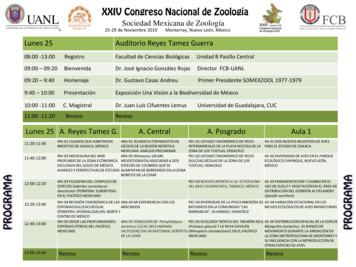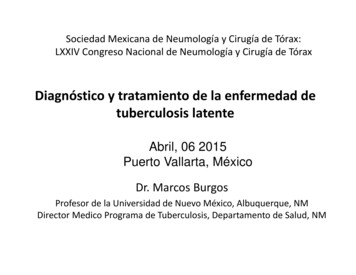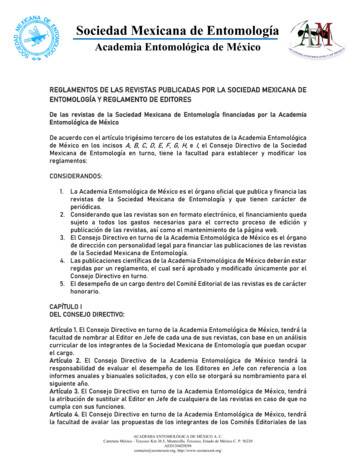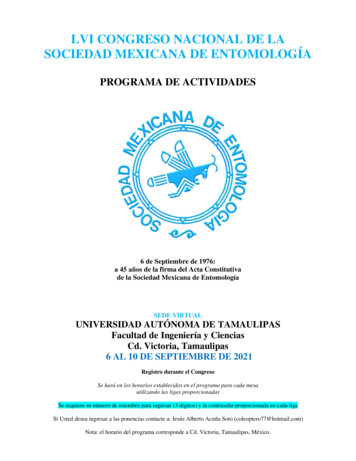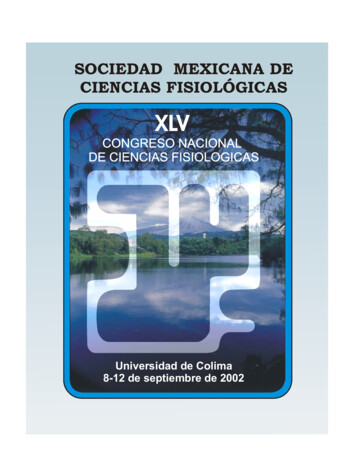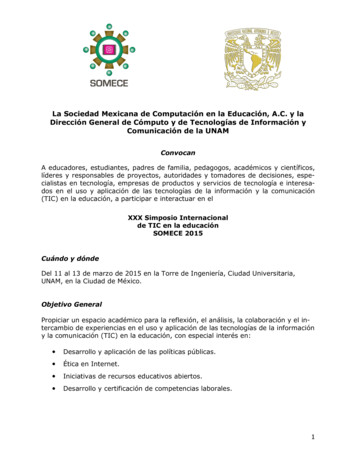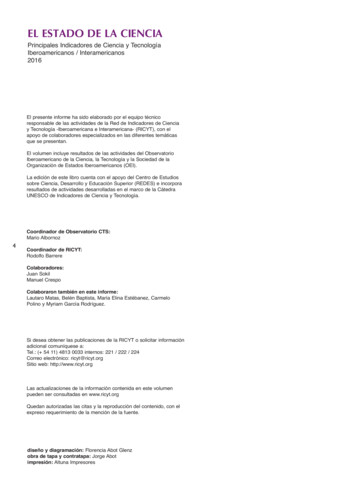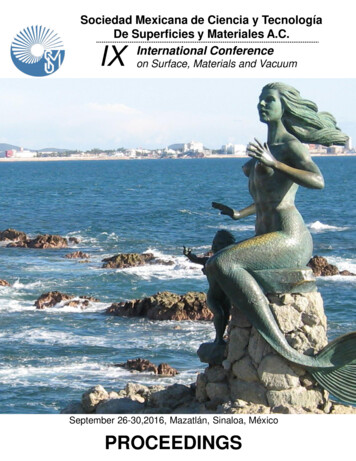
Transcription
Sociedad Mexicana de Ciencia y TecnologíaDe Superficies y Materiales A.C.International ConferenceIXon Surface, Materials and VacuumSeptember 26-30,2016, Mazatlán, Sinaloa, MéxicoPROCEEDINGS
Sociedad Mexicana de Ciencia y Tecnología de Superficies y Materiales A.C.IX International Conference in Surfaces, Materials and VacuumSeptember 26th-30th , Mazatlan, Sinaloa, MéxicoORGANIZINGCOMMITTEEJuan Hernández RosasUPIITA-IPNGregorio Hernández CocoletziIFUAPServando Aguirre TostadoCIMAVEmmanuel Haro PoniatowskiUAM-IztapalapaLeticia Pérez ArrietaUAZCristo Manuel Yee RendónUASClaudia Mendoza BarreraMicrona-UVLOCAL ORGANIZINGCOMMITTEEUASJuan Eulogio Guerra LieraRector-UASJorge Luis Almaral SánchezIngeniería Mochis-UASINTERNATIONALSCIENTIFIC COMMITEELuisa Gonzalez Sotos.Instituto de Microelectrónica (CSIC)Madrid, EspañaCarlos TralleroUniversidad de la Habana - CLAFGary McGuire.International Technology CenterPatricia ThielAVS, USAYuri Gurevich.CINVESTAV-IPNAndres Rosales RiveraUniversidad Nacional de ColombiaHugo Ricardo Navarro ContrerasCYACYT, UASLP, MéxicoPROGRAMCOMMITTEENaboru Takeuchi/CNYN-UNAMMaría Teresa Romero de la Cruz /FCFMUAdeCJesús Heiras Aguirre/CNYN-UNAMVerónica de la Luz Tlapaya /UAMIztapalapaPierre Giovanni Mani González/UACJEduardo Martínez Guerra/CIMAVMonterreyCésar Márquez Beltrán/BUAPRoberto Machorro/CNYN-UNAMCiro Falcony Guajardo/CINVESTAV-DFGiancarlo Righini /Centro FermiWilfrido Calleja/INAOEHoracio Estrada Vázquez/CENAMMáximo López/CINVESTAV-DFJaime Santoyo Salazar/CINVESTAV-DFEsteban Cruz Hernández /UASLPGuillermo Santana/IIM-UNAMMario Fidel García Sánchez /UPIITA-IPNJosé G. Quiñones-Galván /CUCEI-UdeGMiguel Ángel Santana-Aranda/CUCEI,UdeGMario Enrique RodríguezGarcía/CFATA-UNAMSergio Jiménez/CINVESTAV-QroSalvador GallardoHernández/CINVESTAV-DFSandra Rodil/IIM-UNAMGiovanni Ramírez/Argonne NationalLaboratoryJoaquín Oseguera Peña/ITESMGelacio Atondo RubioLaboratorio de Óptica, FCFM-UASOscar Jesus Velarde EscobarLaboratorio de Óptica, FCFM-UASCristo Manuel Yee RendonLaboratorio de Óptica, FCFM-UAS-2
Sociedad Mexicana de Ciencia y Tecnología de Superficies y Materiales A.C.IX International Conference in Surfaces, Materials and VacuumSeptember 26th-30th , Mazatlan, Sinaloa, MéxicoDear Colleagues,From the very beginning the Annual Conference of the Sociedad Mexicana de Ciencia y Tecnología deSuperficies y Materiales (SMCTSM, Mexican Society of Science and Technology of Surfaces andMaterials) has been an important forum used by the Mexican scientific community for the discussion ofscientific and technological topics related to research in the areas of surface and materials science.In these ocation we are pleased to welcome you to participate in the IX International Conference onSurface, Materials and Vacuum (ICSMV) which will held in the city of Mazatlán, Sinaloa from the 26thto the 30th of September 2016.The scientific program of the Conference is divided into plenary conferences, short courses and thedifferent symposia with oral and poster contributions. For the IX edition the symposium of Photothermaland Plasma and Vacuum was reverted to two symposia the Photothermal Phenomena and the Plasma andVacumm symposia. We have added the symposium of Advanced Materials Synthesized by ChemicalRoutes and we have two invited symposia the Atomic Layer Deposition and Luminescence Phenomena:Materials and Applications. Additionally to the scientific program, there is a symposium of ScienceDivulgation which is a traditional forum for the bringing together of students and the general public withthe work undertaken and developed within our Society.We hope that the efforts of the organizing committee, sponsors and colleagues will result in an interestingfriendly meeting, providing the opportunity for closer and new interactions between researchers comingfrom the diverse institutions.The IX ICSMVOrganizing Committee SMCTSMSeptember 2016, Mazatlán, Sinaloa, México.3
Sociedad Mexicana de Ciencia y Tecnología de Superficies y Materiales A.C.IX International Conference in Surfaces, Materials and VacuumSeptember 26th-30th , Mazatlan, Sinaloa, MéxicoIX INTERNATIONALCONFERENCE INSURFACES, MATERIALSAND VACUUMPLENARY LECTURES4
Sociedad Mexicana de Ciencia y Tecnología de Superficies y Materiales A.C.IX International Conference in Surfaces, Materials and VacuumSeptember 26th-30th , Mazatlan, Sinaloa, MéxicoOPENING TALKFoams : new promising materialsDominique LangevinLaboratoire de Physique des Solides, Université d’OrsayFoams are dispersions of bubbles in liquids (or solids). Examples of solid foams are insulation materials(glass and polymer foams), and lightweight materials for car industry (metallic foams).A large amount of work is devoted to the understanding of foaming and foam stability. Improving thisknowledge is very important for the control of the different technological processes used to elaboratesolid foams. In these processes, the foam is usually liquid and destabilises due to different mechanisms:gravity drainage, coarsening (gas diffusion from small to large bubbles) and coalescence. We willdescribe the existing knowledge on these mechanisms and show how they can be controlled.We will present examples of solid foams obtained from various gels (made with surfactants, colloidalparticles and polymers) and show how the solidification can be controlled. This will include foams madewith microfluidic devices where the bubbles are monodisperse in size.5
Sociedad Mexicana de Ciencia y Tecnología de Superficies y Materiales A.C.IX International Conference in Surfaces, Materials and VacuumSeptember 26th-30th , Mazatlan, Sinaloa, MéxicoPLENARY LECTURE ITailoring properties of two dimensional transition metal dichalcogenides:looking beyond graphemeTalat RahmanUniversity of Central Florida, USATo be announced6
Sociedad Mexicana de Ciencia y Tecnología de Superficies y Materiales A.C.IX International Conference in Surfaces, Materials and VacuumSeptember 26th-30th , Mazatlan, Sinaloa, MéxicoPLENARY LECTURE IILocalized magnetometry of metallic nanowires using off-axis electron holographyArturo Ponce, Eduardo Ortega and Alfredo BenitezDepartment of Physics and Astronomy, University of Texas at San Antonio. One UTSA Circle, SanAntonio, TX 78249, USA.The comprehensive understanding of nanoscale materials and their physical properties are of greatinterest to the scientific and technological community. In particular, magnetic nanostructures of differentsize, shape and composition possess a great potential to improve current technologies in areas such as:magnetic data storage, electromagnetic sensing 1,2, . Lately, soft magnetic nanowires, (Co, Fe & Ni) havebeen studied for a while experimentally and by simulations, but there still some questions to be address.Soft magnetic nanowires can switch magnetization in two different modes depending on their thickness,these modes are known as the transverse wall mode and the vortex wall mode. In thin ferromagneticnanowires (diameter less than 40nm) a simple domain wall nucleates and propagates along the nanowireaxis, while the reversal of thick nanowires (diameter more than 40 nm) is achieved via localized curlingor vortex mode. The magnetization direction of each magnetic domain will be influenced by themagnetocrystalline anisotropy; typically following the easy magnetization axis, which minimize themagnetocrystalline energy. The magnetization behavior in this nanostructures is dominated by thecompetition between magnetocrystalline anisotropy and shape anisotropy. In many cases thiscompetition between can frustrates the magnetization direction. It is expected that the magnetostaticcoupling between nanostructures have a strong influence on their response to an external field3.Figure 1. (a) Crystal orientation and (b) magneticphase contour maps of the Co nanowire. The crystalorientation map is displayed with respect to thedirection of observation z (color key code displayedon the right) and is over-layered with the reliabilitymap to reveal zones where crystallites overlap. Theoutline of the nanowire is marked by the thin whiteline. Arrows represent the magnetic flux direction1The talk will cover two folds: 1) crystalline orientation phase mapping assisted by a precession electrondiffraction unit for analysis in nanostructures such as metallic nanoparticles and nanowires and 2) theanalysis of the magnetic fields within and surrounding metallic nanowires. The combination of electronholography and crystalline orientation phase mapping can provide of important information not only7
Sociedad Mexicana de Ciencia y Tecnología de Superficies y Materiales A.C.IX International Conference in Surfaces, Materials and VacuumSeptember 26th-30th , Mazatlan, Sinaloa, Méxicoabout the magnetic behavior but the different orientation of the magnetization as function of theorientations of nano-grains in a polycrystalline structure. The analysis of the magnetic behavior andquantitative measurements has been obtained using off-axis electron holography. The retrieved phasefrom holography contains information related to the thickness of the sample, electric potential, latticedistortion for crystalline and finally magnetic fields. The magnetic phase utilizes the interference of twoelectron waves (reference and object) to detect and quantify the electromagnetic field at nanometer scale.In this interference-based approach the magnetic vector potential A within the ferromagnetic nanowirecauses a phase shift in the quantum mechanical wave functions of the electrons passing through thisregion (Aharonov-Bohm effect)4. Once the phase is recovered and separated, the contour of the puremagnetic phase image corresponds to the projected in-plane magnetic induction as well as the crystalorientation map as shown in Figure 1a and 1b. The methods of characterization and image analysis forthe interpretation and extraction of quantitative information of the metallic nanowires will be discussed.1. J. Cantu-Valle, I. Betancourt, J.E. Sanchez, F. Ruiz-Zepeda, M.M. Maqableh, F. MendozaSantoyo, B.J.H. Stadler, A. Ponce, J. Appl. Phys. 118 (2015) 024302.2. J. Cantu-Valle, E. D. Barriga-Castro, V. Vega, J. García, R. Mendoza-Reséndez, C. Luna, V. M.Prida, K. Nielsch, F. Mendoza-Santoyo, M. José-Yacaman, A. Ponce, J. Magn. Magn. Mater. 379(2015) 294–299.3. F. Ruiz-Zepeda, Y.L. Casallas-Moreno, J. Cantu-Valle, D. Alducin, U. Santiago, M. JoséYacaman, M. López-López, A. Ponce, Microsc. Res. Tech. 77 (2014) 980-985.4. Tonomura, N. Osakabe, T. Matsuda, T. Kawasaki and J. Endo, Phys. Rev. Lett. 56 (1986) 792.8
Sociedad Mexicana de Ciencia y Tecnología de Superficies y Materiales A.C.IX International Conference in Surfaces, Materials and VacuumSeptember 26th-30th , Mazatlan, Sinaloa, MéxicoPLENARY LECTURE IIIIn‐situ Characterization of Atomic Layer Deposition (ALD)Jiyoung KimThe University of Texas at Dallas, Richardson, TX 75080Atomic Layer Deposition (ALD) has been widely utilized to deposit high quality high‐k dielectrics withultra‐precise thickness controllability. Particularly, during the initial few cycles of ALD, metal precursorsand reactants are exposed to different environments because of a substrate unlike in the middle of ALDprocess. Anomalous initial growth behaviors, therefore, are frequently observed at the initial ALDprocess. As devices are being continuously scaled down sub‐10 nm node, it is critical to understandimpacts of initial ALD process on interface characteristics as well as high‐k dielectric deposition.Precursors and reactants for high‐k dielectrics frequently exhibit strong interactions with a channelsubstrate, such as Si and III‐V, during the first few cycles of ALD. Particularly, some of ALD precursorsshow a very high reactivity (or catalytic behavior) with a substrate at a processing temperature. Forexamples, La(fmd) enhances formation of La‐silicate on Si substrate, while TMA (Trimethyl‐Al)effectively remove native oxide at GaAs surface. On the other hand, some 2‐D materials withhydrophobic nature, such as graphene and Mo2S, etc., would prevent appropriate adsorption of reactantson the basal plane, which causes non‐uniform nucleation. If a chemical functionalization technique isapplied to improve ALD nucleation process, performances of the channel would be frequently degraded.In this presentation, I am going to introduce in‐situ XPS system clustered to thermal ALD to investigatesurface reactions during the initial few half cycles of ALD on Si and GaAs. I will also mention in‐situelectrical characterization on 2D devices for initial few half cycles of ALD process.9
Sociedad Mexicana de Ciencia y Tecnología de Superficies y Materiales A.C.IX International Conference in Surfaces, Materials and VacuumSeptember 26th-30th , Mazatlan, Sinaloa, MéxicoPLENARY LECTURE IVManganese nitride magnetic nanopyramids: ab initio calculationsJonathan Guerrero and Noboru Takeuchi*Centro de Nanociencias y Nanotecnología, Universidad Nacional Autónoma de MéxicoAntiferromagnets are very important materials in spintronic devices due to their ability to modify theswitching behavior of adjacent ferromagnets. Both Mn3N2 and MnN are antiferromagnetic materials, andtheir (001) surfaces form nanopyramids. Although structurally similar, these nanopyramids showdifferent electronic and magnetic properties. Since these two materials are potential substrates to formferromagnetic/antiferromagnetic heterostructures, a good knowledge of their atomic arrangements andmagnetic properties is needed. Therefore, we have performed first principles total energy calculationsusing spin polarized density functional theory calculations of bulk Mn 3 N 2 and MnN and their (001)surfaces. The stability of the different surface terminations is calculated using the surface formationformalism. It has been found that the Mn 3 N 2 (001) and MnN(001) nanopyramids are formed by threeand two different terraces, respectively, in agreement with experimental observations. We also compareour Tersoff-Hamman STM and ILDOS simulations with the experimental STM images. A goodagreement between them has been found.We thank DGAPA Project # IN100516 and Conacyt project # 164485. Calculations were performedat the DGCTIC-UNAM Supercomputing Center, with the grant # SC16-1- IG-31.*e-mail takeuchi@cnyn.unam.mx10
Sociedad Mexicana de Ciencia y Tecnología de Superficies y Materiales A.C.IX International Conference in Surfaces, Materials and VacuumSeptember 26th-30th , Mazatlan, Sinaloa, MéxicoPLENARY LECTURE VStraightforward synthesis of ZnO nanostructures compatible with silicon technology*M. Meléndez-LiraDepartamento de Física, Cinvestav -IPN and Departamento de Ciencias Básicas, UAM-ASilicon is the base material of the huge technological development in electronic technology. There isno discussion about the importance of this material in the increasing performance of computers and therelatively new Internet of Things (IoT). However because of its electronic characteristics, indirect andlow energy band gap, there are some technological applications in which silicon is not an adequatematerial or its performance is surmounted by other materials. Two examples of the above are photovoltaicand photocatalytic applications; both of them will have a big impact on the future of humanity. Bycontrast ZnO a transparent semiconductor with a direct bandgap of 3.4 eV is ideal for some applications:detection and emission of UV light, transparent displays, water photolysis, etc. Most of the ZnOelectronic propertiesare enhanced by the formation of nanostructures. The production of ZnOnanoparticles using low cost methods is inadequate for some applications due to chemical residues. Wehave developed a low cost methodology compatible with silicon technology. ZnO nanoparticles areself-assembled within a silicon oxide matrix by employing RF reactive sputtering. In this talk we willpresent a general discussion of the recent advances along with some perspectives in the photovoltaicand photocatalytic applications of ZnO.Our methodology to produce ZnO nanostructures will be presented along with results of the chemical,structural, optical and electrical characterization. Finally, we will comment on the possible applicationsof the produced material.*: Partial financial support by CONACyT is acknowledged.11
Sociedad Mexicana de Ciencia y Tecnología de Superficies y Materiales A.C.IX International Conference in Surfaces, Materials and VacuumSeptember 26th-30th , Mazatlan, Sinaloa, MéxicoPLENARY LECTURE VIProduction of refractive structures and waveguide integrated optical devices by femtosecondlaser structuringJavier SolisLaser Processing Group, Instituto de Optica, CSICThe use of ultrashort laser pulses enables coupling laser energy insidedielectric materials via non-linearabsorption. Already in 1996, the pioneering work of Kazuyuki Hirao and coworkers showed that thisapproach can be used for writing optical waveguides inside fused silica and other glass materials. Sincethen, sub-surface, fs-laser structuring has been used to produce a wide variety of active and passivephotonics components with a performance comparable to that achievable with more conventionaltechniques. The presentation will provide an overview on the production of refractive structures andwaveguide integrated optical devices by femtosecond laser structuring, with emphasis in our recent workon the use of fs-laser induced ion-migration for the production of high index contrast refractive structures.12
Sociedad Mexicana de Ciencia y Tecnología de Superficies y Materiales A.C.IX International Conference in Surfaces, Materials and VacuumSeptember 26th-30th , Mazatlan, Sinaloa, MéxicoPLENARY LECTURE VIIDesign of Metal-organic frameworks: Applications from catalysis to gas adsorptionBerenice González SantiagoDepartamento de Química, Universidad Autónoma Metropolitana-IztapalapaMetal-organic frameworks (MOFs) are a class of porous materials which have been shown to exhibitproperties that make them strong candidates for post combustion carbon capture and storage (CCS)processes and catalysts. These materials can have a diverse range of framework architectures because ofthe wide variety of coordination geometries between the metal cations and the organic ligands, whichassemble in 2D, and 3D structures. MOFs possess significant potential catalytic advantages over‘classical’ porous solids, and in this talk I will describe the synthesis and fuctionalizacion of known andnovel MOFs and their applications in environmental catalysis and carbon dioxide capture.13
Sociedad Mexicana de Ciencia y Tecnología de Superficies y Materiales A.C.IX International Conference in Surfaces, Materials and VacuumSeptember 26th-30th , Mazatlan, Sinaloa, MéxicoPLENARY LECTURE VIIISecond harmonic generation in nanostructured metamaterialsW. Luis MochánICF-UNAM, Cuernavaca, Morelos, MéxicoWe develop a representation of the linear microscopic response of a nanostructured binary periodicmetamaterial that allows the efficient calculation of its macroscopic response and its linear microscopicfield for arbitrary geometries, composition and frequencies. The linear field allows us to obtain thedipolar surface contributions and quadrupolar bulk contributions to the nonlinear processes of three wavemixing such as second harmonic generation (SHG). The quadratic response has a multipolar characterwhen the building materials and the geometry is centrosymetric. However, when the geometry lacks aninversion point the nonlinear response becomes enhanced and acquires a dipolar character even when thebuilding materials are centrosymmetric. This suggests a strategy for obtaining a large SHG from ordinarymaterials.14
Sociedad Mexicana de Ciencia y Tecnología de Superficies y Materiales A.C.IX International Conference in Surfaces, Materials and VacuumSeptember 26th-30th , Mazatlan, Sinaloa, MéxicoPLENARY LECTURE IXTwo-dimensional materials, heterostructures and devicesXiangfeng DuanDepartment of Chemistry and Biochemistry & California Nanosystems InstituteUniversity of California, Los Angeles, Los Angeles, California 90095 USATwo-dimensional layered materials (2DLMs), such as graphene or molybdenum disulphide, represent anideal 2D material system for exploring fundamental chemistry and physics at the limit of single atomicthickness. The covalently bonded atomic layers in 2DLMs are bound weakly to each other through vander Waals interactions, which offers considerable flexibility to isolate, mix and match individual atomiclayers without the constraints of lattice and processing compatibility. It can therefore open up vastpossibilities for nearly arbitrarily combining multiple materials and integrating distinct properties at theatomic scale, and thus enabling entirely new opportunities beyond the reach of existing materials. HereI will focus my discussion on exploring these 2D materials and their heterostructures as new platformsfor the creation of a wide of electronic and optoelectronic devices with unique functions or unprecedentedperformance. Examples discussed include: high-speed transistors; a new design of vertical transistors forultra-flexible electronics; and several new types of tunable photonic devices.Email: xduan@chem.ucla.edu; http://xduan.chem.ucla.edu15
Sociedad Mexicana de Ciencia y Tecnología de Superficies y Materiales A.C.IX International Conference in Surfaces, Materials and VacuumSeptember 26th-30th , Mazatlan, Sinaloa, MéxicoPLENARY LECTURE XTime-of-flight mass spectrometry in laser-matter interaction studiesAlexander V. BulgakovS.S. Kutateladze Institute of Thermophysics, SB RAS, Novosibirsk, RussiaMass spectrometry (MS) is one of the most powerful techniques to study processes occurring verviewofusing MStechniquesin laserablation/desorption/excitation experiments will be given. The main types of mass spectrometers andtypical experimental schemes will be considered. The main attention will be paid to time-of-flight (TOF)MS as to the most informative and frequently used technique. The use of TOF MS will be illustrated byexamples of author’s studies of various aspects of laser-matter interaction including synthesis ofnanoclusters, dynamics of laser-ablation plasmas, pulsed laser deposition, laser excitation of gas-phaseclusters, and laser-induced forward transfer of nanoparticles.16
Sociedad Mexicana de Ciencia y Tecnología de Superficies y Materiales A.C.IX International Conference in Surfaces, Materials and VacuumSeptember 26th-30th , Mazatlan, Sinaloa, MéxicoPLENARY LECTURE XIUp- and down-conversion in photoluminescent glasses for enhanced photovoltaics: recentadvancesG.C. RighiniMuseo Storico della Fisica e Centro Studi e Ricerche Enrico Fermi, Roma, 00148, ItalyNello Carrara Institute of Applied Physics, CNR-IFAC, Sesto Fiorentino, 50019, ItalyEfficient light manipulation at sub-wavelength scale is of great interest for the enhancement of theefficiency of solar cells. Performance of any solar cell is determined by the efficiency of theabsorption process of light via excitation of electron‐hole pairs and extraction of these generatedcharge carriers (electrons and/or holes). The absorption, in turn, has a number of limiting factors:one is related to the small size and acceptance angle of the active region; another is due to thereduced spectral sensitivity of the active material, which could not make use of a part of the solarspectrum.Correspondingly, the energy harvesting may be improved in two ways: a) light trapping schemesmay be adopted in order to make the cell “thicker” by exploiting scattering and/or reflection effects,which effectively increase the optical path inside the photoconductive material. Plasmonicstructures, constituted by patterned metal films or nanoparticles, have demonstrated to be veryeffective for directing and enhancing the incident light beam. b) up- and down-conversionprocesses may be exploited to convert the frequencies of the solar spectrum from near-mid-IR andfrom uv regions, respectively, to the visible region of maximum absorption of the cell. Thin glassyor glass-ceramic films doped with rare earths have proved to be very suitable for this purpose.Here an overview of recent results achieved, in particular, in the field of up- and down- frequencyconversion by different research groups will be reported, and different approaches will becompared.Acknowledgments: The collaboration and critical discussions with several colleagues (C. Armellini,F. Coccetti, F. Enrichi, M. Ferrari, F. Gonella, A. Łukowiak, S. Pelli, A. Quandt, L. Z. Zur) aregratefully acknowledged17
Sociedad Mexicana de Ciencia y Tecnología de Superficies y Materiales A.C.IX International Conference in Surfaces, Materials and VacuumSeptember 26th-30th , Mazatlan, Sinaloa, MéxicoPLENARY LECTURE XIPulsed Laser Deposition of 2D and Bulk II-VI MaterialsManuel A. Quevedo-LopezDepartment of Materials Science, University of Texas at DallasIn this talk pulsed laser deposition (PLD) methods are presented to study p-n II-VI homo andheterojunctions fabricated in-situ. In-situ film deposition allows higher quality p-n interfaces byminimizing spurious contamination from the atmosphere. Morphologic and structural analyses werecarried for CdTe films deposited on various substrates and different deposition conditions and theelectrical characteristics and performance of the resulting junctions are studied. In addition, a scalableand catalyst-free method to deposit stoichiometric two dimensional molybdenum disulfide (2D MoS 2)films over large areas is reported with the maximum area limited by the size of the substrate holder. Themethod allows deposition of MoS2 layers on a wide range of substrates without any additional surfacepreparation including single crystals (sapphire and quartz), polycrystalline (HfO 2), and amorphous(SiO2). The films are deposited using carefully designed MoS 2 targets fabricated with excess of sulfur(S) and variable MoS2 and S particle size. Uniform and layered MoS2 films as thin as two monolayers,with an electrical resistivity of 1.54 10 4 Ω cm-1 were achieved. The MoS2 stoichiometry was asconfirmed by High Resolution Rutherford Backscattering Spectrometry (HRRBS). With the methodreported here, in situ graded MoS2 films ranging from 1 to 10 monolayers can also be deposited.thickness control is achieved by controlling the growth kinetics by simply manipulating the repetitionrate (frequency) and energy of the laser as well as the deposition pressure. The absorption of the laserenergy by this a volume consequently forms a plasma, or plume, at the surface of the target and thespecies get transferred to the substrate. This process is not dependent on the partial pressures of theconstituent cations.1 However, the deposition pressure can be used to modify the mean free path of theablated species to either minimize or maximize the energy of the species reaching the surface of thesubstrate. In PLD processes, only the stoichiometry is transferred from the target to the substrate and thecrystalline phase of the resulting film is not necessarily the same as that of the target. 1 Furthermore, MoS218
Sociedad Mexicana de Ciencia y Tecnología de Superficies y Materiales A.C.IX International Conference in Surfaces, Materials and VacuumSeptember 26th-30th , Mazatlan, Sinaloa, Méxicogrowth on amorphous, polycrystalline and single crystal substrates was also demonstrated. With furtherwork, the method reported here can lead to future large-scale deposition of MoS2 for various applications.Figure 1. MoS2 thin film with graded thickness andthe corresponding Raman mapping. (a) The opticalimage shows a MoS2 thin film thicknesses gradienton half sapphire wafer deposited by PLDthicknesses gradient. Raman spectra and Ramanmapping are shown (b-c). Areas of high and lowintensity are represented by red and blue colors inthe Raman mapping. (d) TEM cross-section resultsfor areas 1 through 5 showing the thickness gradientfor the MoS2 films along the entire substrate.Tel.: 1 972 882 5714 E-mail: mquevedo@utdallas.edu19
Sociedad Mexicana de Ciencia y Tecnología de Superficies y Materiales A.C.IX International Conference in Surfaces, Materials and VacuumSeptember 26th-30th , Mazatlan, Sinaloa, MéxicoIX INTERNATIONALCONFERENCE INSURFACES, MATERIALSAND VACUUMSHORT CURSES20
Sociedad Mexicana de Ciencia y Tecnología de Superficies y Materiales A.C.IX International Conference in Surfaces, Materials and VacuumSeptember 26th-30th , Mazatlan, Sinaloa, MéxicoSHORT CURSE APhysicochemical approach to nanomaterials for nanoscience and nanotechnologyArturo PonceUTSA, USATable of Content1. Why Nano2. Molecular vs materials self-assembly3. Nanopatterning and lithography4. layer-by-layer methods5. Nanorods, nanotubes and nanowires6. Nanocrystalline particles7. Biomaterials at nanoscale8. Self-assembling 2D and 3D nanostructures9. Optical properties in nanomaterials10. Mechanical properties at nanoscale11. Micro and nano-scale characterization methods12. In-situ measurements and response of nanomaterials in real time21
Sociedad Mexicana de Ciencia y Tecnología de Superficies y Materiales A.C.IX International Conference in Surfaces, Materials and VacuumSeptember 26th-30th , Mazatlan, Sinaloa, MéxicoSHORT CURSE BAtomic Layer Deposition (ALD) for Micro‐ and Nano‐ElectronicsJiyoung KimMaterials Science and Engineering, University of Texas at DallasAtomic layer deposition (ALD) is highly regarded as one of the most viable ultrathin film formationtechniques well‐suited for semiconductor devices fabrication with large throughput and relatively lowequipment cost. While, ALD is a subclass of chemical vapor deposition (CVD), its self‐limited workingprinciple distinguishes it from its siblings. Conventional CVDs inject all gas phase chemicals needed forreaction into the chamber simultaneously and continuously, and thus r
Sociedad Mexicana de Ciencia y Tecnología de Superficies y Materiales A.C. IX International Conference in Surfaces, Materials and Vacuum September 26th-30th, Mazatlan, Sinaloa, México ORGANIZING 2 - COMMITTEE Juan Hernández Rosas Luisa Gonzalez Sotos UPIITA-IPN Madrid, España Gregorio Hernández Cocoletzi IFUAP Universidad de la Habana
